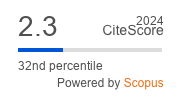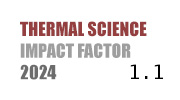THERMAL SCIENCE
International Scientific Journal
Thermal Science - Online First
online first only
Experimental and modelling study on optimization of glass fiber filter diversion structure
ABSTRACT
This study conducts an experimental and modeling investigation on the optimization of the glass fiber filter diversion structure. Addressing the critical issue in air filtration systems of enhancing the service life and performance of filter devices, this research rationally designs and optimizes the structural parameters of the diversion structure. Numerical simulation of the filter device was established through airflow organization experiments of glass fiber filters to explore the impact of various guide vane structure parameters on the system's air distribution uniformity and service life. Furthermore, machine learning was employed to optimize the guide structure of the filtration device based on the results of numerical simulations. The study demonstrates a good agreement between numerical simulation results and experimental outcomes, with an error of less than 10%. The optimal length and angle of the guide plate predicted by machine learning are 163.2 mm and 38.5°, respectively. This research not only injects new momentum into the continuous advancement of air filtration technology but also shows significant potential in energy efficiency and cost control.
KEYWORDS
PAPER SUBMITTED: 2024-11-18
PAPER REVISED: 2025-01-18
PAPER ACCEPTED: 2025-01-19
PUBLISHED ONLINE: 2025-02-16
- Rana, A.K., et al., Cellulose-based materials for air purification: A review, Industrial Crops and Products, 194. (2023),
- Liu, G., et al., A review of air filtration technologies for sustainable and healthy building ventilation, Sustainable Cities and Society, 32. (2017), pp. 375-396
- González-Martín, J., et al., A state-of-the-art review on indoor air pollution and strategies for indoor air pollution control, Chemosphere, 262. (2021), p. 128376
- Le, T.S., et al., Air purification equipment combining a filter coated by silver nanoparticles with a nano-TiO2 photocatalyst for use in hospitals, Advances in Natural Sciences: Nanoscience and Nanotechnology, 6. (2015), 1
- Hyun Min Kim, Evaluation for Infection Control and Indoor Environmental Impact for Temporary Negative Pressure Isolation (TNPI) Chamber in Emergency Wards, Graduate School of Seoul National University,2024
- Lian, Z., et al., Presentation and evaluation of a new type of air supply system in a passenger carriage in China, Applied Thermal Engineering, 24. (2004), 5-6, pp. 703-715
- Knibbs, L.D., et al. AUTOMOBILE HVAC SYSTEMS : AIR FLOW , LEAKAGE AND THEIR EFFECTS ON IN-VEHICLE AIR QUALITY,2008,
- Vijayan, V.K., et al., Enhancing indoor air quality -The air filter advantage, 32. (2015), pp. 473 - 479
- Zhang, M., et al., Evaluation and prediction of fibrous filters' operating performance in residential fresh air system, Building and Environment, 255. (2024), p. 111441
- Yit, J.E., et al., Empirical modelling of filtration performance for the fibrous air filters with final resistance recommendation, Results in Engineering, 16. (2022),
- Afifa, et al., Air pollution and climate change as grand challenges to sustainability, Science of The Total Environment, 928. (2024), p. 172370
- Li, S., et al., Application and research of dry-type filtration dust collection technology in large tunnel construction, Advanced Powder Technology, 28. (2017), 12, pp. 3213-3221
- Cutler, T.D.,J.J. Zimmerman, Ultraviolet irradiation and the mechanisms underlying its inactivation of infectious agents, Animal Health Research Reviews, 12. (2011), 1, pp. 15-23
- Sharma, S., et al., An overview on recent progress in photocatalytic air purification: Metal-based and metal-free photocatalysis, Environmental Research, 214. (2022), p. 113995
- Wang, Z.,J.S. Zhang, Characterization and performance evaluation of a full-scale activated carbon-based dynamic botanical air filtration system for improving indoor air quality, Building and Environment, 46. (2011), 3, pp. 758-768
- Ghosh, N.K., et al., Particle Pollution with PM 2.5, Reduction of Indoor Aeroallergen and Overall Particle Count Using AHPCO and Plasma Hybrid Technology for Air Purification, Journal of Allergy and Clinical Immunology, 143. (2019), 2, p. AB74
- Zhang, X., et al., Establishment of air fiber filtration model based on fractal theory and analysis of filtration performances, Materials Today Communications, 34. (2023), p. 105301
- Bardin‐Monnier, N.,D. Thomas. Initial Pressure Drop for Fibrous Media,2017,
- Wang, A., et al., High efficiency, low resistance and high temperature resistance PTFE porous fibrous membrane for air filtration, Materials Letters, 295. (2021) 129831,
- Li, S., et al., Influence of pleat geometry on the filtration and cleaning characteristics of filter media, Separation and Purification Technology, 210. (2019), pp. 38-47
- Alilou, Y., et al., Airflow characterization within the pleat channel of HEPA filters with mini pleats, The Canadian Journal of Chemical Engineering, 99. (2021), S1, pp. S693-S702
- Teng, G., et al., Influence of pleated geometry on the pressure drop of filters during dust loading process: experimental and modelling study, Scientific Reports, 12. (2022), 20331
- Zhang , Y. Y., RAN Jingyu, XIU Hengxu, Numerical simulation of flow distribution uniformity in TWC and optimal design of catalyst in CNG vehicle, 56. (2005), 9, pp. 1679-1684
- Zhuang, C., et al., Optimization of the Structure of a Solar Air Heater Fitted with V-Shaped Perforated Baffles, International Journal of Heat and Technology, 34. (2016), 4, pp. 604-610
- Menni, Y.,A. Azzi, DESIGN AND PERFORMANCE EVALUATION OF AIR SOLAR CHANNELS WITH DIVERSE BAFFLE STRUCTURES,Computationl Thermal Science, 10. (2018), 3, pp. 225-249
- Shuqi, Z., et al., Artificial neural network-based optimization of baffle geometries for maximized heat transfer efficiency in microchannel heat sinks, Case Studies in Thermal Engineering, 49. (2023), p. 103331
- Li, J.-L., et al., Numerical simulation and thermal performance optimization of turbulent flow in a channel with multi V-shaped baffles, International Communications in Heat and Mass Transfer, 92. (2018), pp. 39-50
- Luo, Z.T.-F., Zhang Y-F,Bao M,Yu G-C, Optimal design of air purifier filter element based on CFD, Proceedings of China Household Appliance Technology Conference 2020. 2020: Linbo, China. p. 1521-1524
- Cheng, K., et al., CFD-DEM simulation of particle deposition characteristics of pleated air filter media based on porous media model, Particuology, 72. (2023), pp. 37-48
- Xu, L.J.-C., Su F,Dong Y-D, Structure improvement and flow performance analysis of air purifier, Journal of Xi'an Polytechnic University, 32. (2018), 2, pp. 216-221,236
- Shi, T., et al., Novel process optimization based on machine learning: A study on biohydrogen production from waste resources, Biomass and Bioenergy, 185. (2024), p. 107222
- Alli, Y.A., et al., Optimization of 4D/3D printing via machine learning: A systematic review, Hybrid Advances, 6. (2024), p. 100242
- Santagata, T., et al., Modelling and experimental characterization of unsaturated flow in absorbent and swelling porous media, Chemical Engineering Science, 224. (2020), p. 115765
- Jafari, A., et al., An eXtended finite element method implementation in COMSOL multiphysics: Thermo-hydro-mechanical modeling of fluid flow in discontinuous porous media, Computers and Geotechnics, 159. (2023), p. 105458
- Santamaría Bertolín, L., et al., Optimal position of air purifiers in elevator cabins for the improvement of their ventilation effectiveness, Journal of Building Engineering, 63. (2023), p. 105466
- Tryggvason, G., Chapter 6 - Computational Fluid Dynamics, in: Fluid Mechanics (Sixth Edition), (Ed., Editor^Editors), Academic Press: Boston. 2016, pp. 227-291
- Wang, F., et al., The Turbulent Schmidt Number for Transient Contaminant Dispersion in a Large Ventilated Room Using a Realizable k-ε Model, Fluid Dynamics and Materials Processing, 20. (2024), 4, pp. 829-846
- Hernandez-Rodriguez, R., et al., Momentum transport in the free fluid-porous medium transition layer: one-domain approach, Chemical Engineering Science, 248. (2022), p. 117111
- Fang, J., et al., Machine learning accelerates the materials discovery, Materials Today Communications, 33. (2022), p. 104900
- Hu, Y., et al., Fusion dynamical systems with machine learning in imitation learning: A comprehensive overview, Information Fusion, 108. (2024), p. 102379
- Jiang, Q., et al., Hybrid multilayer perceptron and convolutional neural network model to predict extreme regional precipitation dominated by the large-scale atmospheric circulation, Atmospheric Research, 304. (2024), p. 107362
- Tao, H.-G., et al., An alternative approach to quantifying fluid flow uniformity based on area-weighted average velocity and mass-weighted average velocity, Energy and Buildings, 45. (2012), pp. 116-123
- Zhong, X.Z.L.W.U.C.-b., Experiments and Numerical Simulation of Flow Distribution with Larger Flux in Multi-branch Pipe, JOURNAL OF CHONGQING UNIVERSITY, 29. (2006), 1, p. 41
- L-Y, S., et al., Optimization of the baffle structure of plasma generator %J Journal of Harbin University of Commerce(Natural Sciences Edition), 40. (2024), 1, pp. 57-63
- Zhang, R., et al., Review of Deep Learning, abs/1804.01653. (2018),
- Sudjianto, A., et al., Unwrapping The Black Box of Deep ReLU Networks: Interpretability, Diagnostics, and Simplification, abs/2011.04041. (2020),
- Yang, L., et al., A local space transfer learning-based parallel Bayesian optimization with its application, Chinese Journal of Chemical Engineering, 74. (2024), pp. 227-237
- Scyphers, M.E., et al., Bayesian Optimization for Anything (BOA): An open-source framework for accessible, user-friendly Bayesian optimization, Environmental Modelling & Software, 182. (2024), p. 106191

